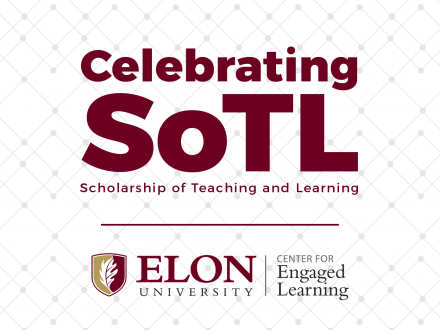CEL Scholar David Buck is investigating the impact of and best practices for collaborative projects.
Each spring, the Center for Engaged Learning (CEL), the Center for the Advancement of Teaching and Learning (CATL), and the Center for Research on Global Engagement (CRGE) join together to showcase research projects focused on the Scholarship of Teaching and Learning (SoTL). Follow along this week as we share Elon scholars’ research on innovative teaching practices through a series of Today at Elon articles.
Love them or hate them, group projects are a huge part of many college courses. Many instructors assign them, sometimes out of necessity to facilitate in-depth projects in large classes and sometimes in an effort to teach students important collaboration skills. Any collaborative project is going to bring with it a lot of complexity and many questions for instructors to resolve: how to assign groups, how to guide students as they work together, how to assess the projects.
 Elon Associate Professor and Center for Engaged Learning Scholar David Buck is taking a close look at the evidence for the impact of collaborative projects and the recommendations for how to implement them well. Collaborative assignments and projects are one of the 11 high-impact practices identified by higher education researchers as experiences that contribute to positive outcomes for college students. Buck teaches a research methods course in psychology, in which he created a semester-long group research project for the class. It was a large project, and both because of the scope and because scientific research is often the product of collaboration it made sense for it to be a group project.
Elon Associate Professor and Center for Engaged Learning Scholar David Buck is taking a close look at the evidence for the impact of collaborative projects and the recommendations for how to implement them well. Collaborative assignments and projects are one of the 11 high-impact practices identified by higher education researchers as experiences that contribute to positive outcomes for college students. Buck teaches a research methods course in psychology, in which he created a semester-long group research project for the class. It was a large project, and both because of the scope and because scientific research is often the product of collaboration it made sense for it to be a group project.
“Anyone who’s been a student who’s worked on group projects has had the experience of them not going well,” Buck says. “And I know that can be incredibly frustrating, and that frustration could, in some cases, be counterproductive for learning.”
For his CEL Scholar research project, Buck is taking a deep dive into the literature of collaborative assignments to identify best practices. And what he’s finding is that the evidence is not as conclusive as we might assume that collaborative projects support learning. “A lot of the research I’ve seen is focused on comparing the products produced by groups of students with those produced by individual students, and I think we need to be cautious about what we infer from those comparisons,” Buck says.
 The research is clear that when five people work together, their final product is likely going to be better than if one person completed it. But does that mean that the students — all the students — actually learned more? Evaluating student learning and perceptions of learning is complex, and we still have plenty to investigate about how students learn through group projects.
The research is clear that when five people work together, their final product is likely going to be better than if one person completed it. But does that mean that the students — all the students — actually learned more? Evaluating student learning and perceptions of learning is complex, and we still have plenty to investigate about how students learn through group projects.
When asked to briefly share his best tips for instructors doing group projects, he addressed two issues: teaching for collaboration and group selection. A key learning outcome for a collaborative project should be learning to collaborate!
“A big part of the impact of these projects is on teaching people how to collaborate, so if you have a group that’s not going smoothly, that’s still not necessarily a problem—because that will happen in life, and as long as students are learning to navigate the conflict effectively, that’s a good thing,” Buck says.
However, as instructors, we need to understand our role in making this happen. In the same way that you wouldn’t sit a student in front of a piano for the first time and just say, “play, and I’ll grade your performance,” you shouldn’t put students in a group and just say “collaborate.” To fulfill a project’s potential to help students learn to collaborate, you must prepare them, provide guidance, and discuss strategies that might help them work together effectively. In other words, collaboration needs to be part of the curriculum.
His other advice is to think carefully about how groups are assembled. It can be a difficult balancing act to provide students some choice while still making sure that you’re not “creating scenarios reminiscent of being picked last for dodgeball.” His current preferred method is to ask students if they have peers they’d like to work with (or NOT work with), but also assign groups according to logistics (usually scheduling for availability for group meetings). You can read much more in-depth discussion of these two issues, as well as many other aspects of collaborative projects, on Buck’s posts to the Center for Engaged Learning blog.
This SoTL research is a natural extension of Buck’s disciplinary research: as a social psychologist, Buck studies how people interact with others and their environment, “and how people collaborate and how groups work is very much a part of what my field does.”
He appreciates how the CEL Scholar position provides him with time and space to explore the intersection of his discipline and teaching and learning. “Doing SoTL is very aligned with Elon’s teacher-scholar-mentor model, the merging of teaching and scholarship,” Buck says. “Because evidence-based pedagogy is such a big part of my teaching philosophy, doing this type of research is an important aspect of teaching development for me.”
During a two-year appointment, CEL Scholars develop expertise in a specific aspect of engaged learning and create resources on that topic to be shared through CEL’s website and in other scholarly venues. The CEL Scholar position is an opportunity for an Elon faculty member to develop and deepen a professional development trajectory that includes scholarly activity on a high-impact practice or other engaged learning topics. Learn more about the CEL Scholars program.


